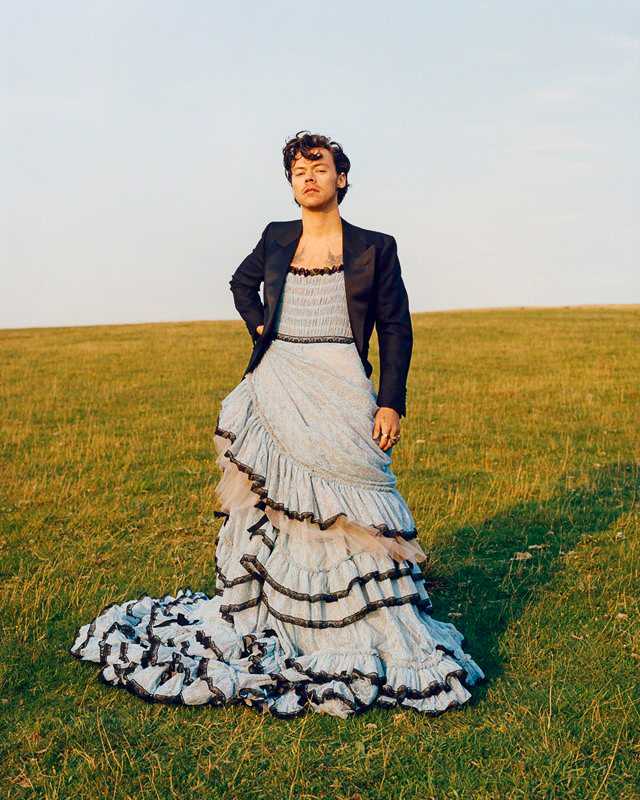The future of fashion is genderless
December 15, 2020
Clothing is not only a way to stay warm in winter or look presentable at a job interview; it is more than a daily chore of getting dressed for school. For many people, it is a form of creativity and artistic expression. Through different colors, patterns, aesthetics and silhouettes, fashion allows people to embody themselves through pieces of fabric and represent their emotions, personalities and identities and can make them feel more confident and powerful.
“In fashion, there is no right or wrong,” junior Megan Hillyer said.
So why is there a stigma surrounding men who wear conventionally female clothing and women who wear conventionally male clothing? If fashion is about self-expression, why is it deemed wrong for men to wear skirts? It isn’t wrong, but the patriarchy has declared men too tough to wear feminine clothing and women not good enough to wear masculine clothes. Not to mention that the fashion industry has continued to disregard gender identities outside of the binary male and female.
“I remember hearing about two men who were denied service at a restaurant because they were wearing skirts,” junior Nate Calefati said.
The men that Calefati referred to felt comfortable and confident in their skirts and were rejected by society because of it. Unfortunately, this is not the first or last time this will happen and should not continue. After Vogue released a photoshoot with Harry Styles wearing dresses and feminine clothing, conservative author and activist Candace Owens attacked him proclaiming that we need to bring back “manly men.” What needs to be normalized is people wearing whatever they want without fear of judgment.
Recently, more and more celebrities have rebelled against gender constructs in fashion. These celebrities are either protesting against toxic masculinity or genuinely feel comfortable and confident in these clothes. This has inspired teens everywhere to ignore the stigma and simply wear what they like.
“It was only until recently that I’ve been trying to expand my understanding of clothing and new styles; I think being in quarantine and having a lot of free time has helped me experiment with clothing and styles that I have never worn before,” Calefati said.
Some of the most notable icons who break gender norms in fashion include Harry Styles, Timothee Chalmet, Jack Dylan Grazer, Jaden Smith, BTS, Billie Eilish, Billie Porter and Cara Delevigne. Not to mention, male influencers on Tik Tok have started painting their nails and wearing skirts. Likewise, many female Tik Tok influencers have been seen sporting suit pants and baggy, street-style clothes.
“I think that, especially with young kid’s clothing, there shouldn’t be “boys” and “girls” sections anymore,” Teddie Liederman, president of the Scotch Plains-Fanwood High School Fashion Club, said. “Even though I am a very traditionally feminine person now as a teenager, when I was little I was really into Legos and Angry Birds and I was upset that they only had Lego-themed shirts in the boy’s section and never in the girls. There are a lot of things that could be done to accommodate more people.”
This is not the first time in history that these traditional ideas have been challenged. Take Katherine Hepburn, Marlene Dietrich, Bridgett Bardot, Grace Jones, Prince and David Bowie, for example, all have a history of wearing stylish suits in their lines of work and in their daily lives.
“I was outside of race and gender,” Jones said in an interview with Vanity Fair. “I considered myself energy that had not been classified.”
Not only should men and women feel free to wear any type of clothing, people of other genders, such as non-binary or gender fluid, should not have to feel restricted. Being misgendered can be very hard for those who aren’t cisgender, and if clothing wasn’t always associated with male or female, these groups would hopefully feel more comfortable and not boxed into a category.
“Especially with little kids, [gendered clothing] could start putting them in a box before they know anything and it starts giving them labels before they can decide what labels they want to use themselves,” Liederman said.
Louis Vitton is a great example of a popular brand that attempted to make their clothing more inclusive in this aspect. In their Spring/Summer clothing line displayed in Paris Fashion Week 2019, their women’s collection included suits, bomber jackets and boxy trousers.
“There was a clear ambiguity, but that was the idea,” Nicolas Ghesquière, director of the house of Louis Vuitton, said, according to Vogue. “Sometimes people think when a woman dresses like a man it gives her power, but you can be very vulnerable when you’re wearing a suit as a woman.”
Fashion means a lot of different things to a lot of different people, so society should normalize all of those diverse opinions and incorporate them into clothing lines and fashion shows. This way, everyone can be themselves without discrimination and find their own identities without the pressure of the outdated view of gender.
“At the end of the day, clothing is just clothing,” Calefati said.
Photo courtesy of Vogue



